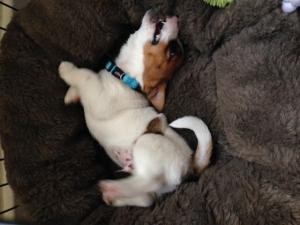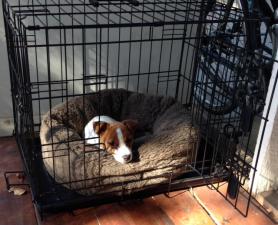Short term confinement in a crate can make all the difference to successfully training a puppy. The best way to prevent accidents and problem behaviours in puppies is to never let them happen in the first place. This is best done with continuous supervision but for most of us this is not always possible.
The Benefits Of Crate Training A Puppy
Crates are for:
- Toilet training (potty training)
- Safety of dogs & children
- Feeding puppies
- Getting puppies accustomed to confinement
For example, when cooking dinner, showering or changing a nappy we often need somewhere we can put a puppy so they won’t come to harm and won’t learn bad habits while unsupervised.
A crate should never be used simply for the dog owner’s convenience. It is a training, safety and calming tool when used well. The crate should be closed for the minimum time needed, hopefully only minutes at a time, and never for more than three or four hours during daytime. Its use must be balanced by the owner also providing exercise and play for at least the same amount of time so the crate can be used for ‘down time’ only. A crate is a failure when a puppy or dog is distressed inside it, or is excited and active.

Crates are a success when a puppy learns to associate them with sleep time, is relaxed inside, and enters willingly (that’s the vet’s pup Loki having a play in his crate). These puppies will become dogs who continue to enjoy sleeping in the crate through their adult life, with the door open as a natural dog den. Dogs instinctively like a semi-enclosed sleeping place, probably for the security it provides.
So why do we recommend crating puppies and dogs?
Crates For Toilet Training
Toilet training is at its core a very simple concept. Dogs have no innate knowledge that toileting in a certain place is wrong or right. They have to be taught where to toilet, which is usually the hardest thing a new pet owner faces. They learn where to go by rewards and habit. In order to achieve this, the owner needs to be there when the puppy toilets, in order to direct them to the right place, and reward them afterwards.
If a puppy is toileting in the house without supervision, they are also learning to go there. People who let their puppies roam freely in the house rarely have well toilet trained dogs. This means the process drags on for many months, causing much frustration and preventing the puppy having full access to the home and family.
Done well, crating helps by shortening the toilet training time considerably. The crate is used when the puppy can not be supervised or left in the right place to go. For example, if the owner has to take a shower, cook dinner, pick up the kids from school, etc these are good times to use the crate. The crate should be no larger than can hold a bed and a food and water bowl. As soon as the owner returns, they need to take the puppy out to toilet immediately.
Overnight, the need to exercise or toilet is much less, and the time in the crate can be longer. For pups under 12 weeks of age, the owner should get up in the middle of the night to give the puppy a toilet break. After 12 weeks, most puppies can easily last the night as long as the owner is prepared to get up just before the puppy’s normal waking time (usually sunrise).
Keeping Puppies & Kids Safe
Those who have followed our weekly articles will remember Andrew’s puppy, Loki being poisoned. He had normally been using a crate but just that one time, he left him out. It was in this brief time that he found and ingested the ivy berries that could have killed him.
Puppies will chew, eat and explore anything they can. A puppy unsupervised will repeatedly put themselves in danger, whether by poisoning, drowning, electrocution or foreign body ingestion.
Similarly, children are at risk if they disturb dogs when they are sleeping (hence “let sleeping dogs lie”). Even the best dog will often bite if jumped on when asleep, just because they aren’t awake enough to control their response. To make it worse, small children just can’t leave dogs alone in their beds.
Far better to allow dogs to sleep in a protected space. You’ll be amazed how much they prefer it that way. Read more about preventing dog bites in children here.
Feeding Puppies
Puppies often eat very slowly and are easily distracted. If there’s an older animal lurking around they will usually take the food while your back is turned and your puppy may not get enough to eat.
If this is happening, a crate is an ideal way to make sure your puppy gets all the food they need.
Preparing Puppies For Confinement
Dogs will have times through their lives when they will need to be confined. This could be transportation, veterinary visits, or safety (eg when tradespeople are coming and going). The ability to sit quietly in a crate is a skill which is quickly noted when we have to hospitalise a dog at the surgery.
How To Crate Train A Puppy
How do we get dogs and puppies used to being crated? The answer is slowly and with patience. If you are lucky, your pup will never complain and you can get started straight away. The key here is to keep them highly active and amused at other times so they are looking forward to a rest when you use the crate.
Most pups are best trained slowly. Use the crate as a feeding place, and experiment with closing and opening the door. Use treats either stuffed in kongs or toys, spread on a LickiMat or hidden in the bed so they spend a long time retrieving the food. Slowly extend the time the puppy is in the crate, but always open then door before the pup starts to complain. To keep them happy, randomly insert a treat or chew toy to keep them amused.
Evidence shows that a DAP collar is likely to help your puppy stay calm when you’re not around. This is especially true once you start trying to go all night.

Of course, use the crate as little as possible, and keep the door open so it can be used by the dog at other times (see Loki taken recently). Place the crate in an area where they can see comings and goings, for example near a crossroads in the house. At the same time, the crate should be in a space that feels secure to the dog, such as against a wall or under a table.
It is probably too much to expect most dogs or puppies to be happy in a crate if they can see their owners nearby so whenever possible, let them out even briefly.
With time, your puppy or dog should be found using the crate whenever they want a secure place to sleep. We hire crates for confinement after orthopaedic surgery and it never ceases to amaze me that the same people who can’t believe their dogs will accept the crate usually end up buying one for their dog afterwards.
